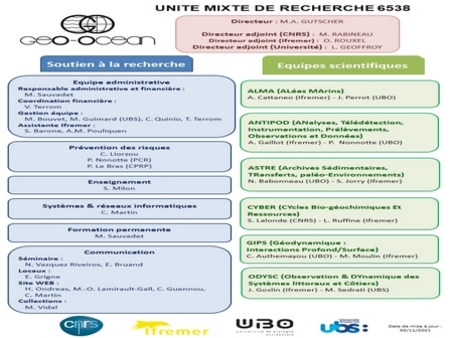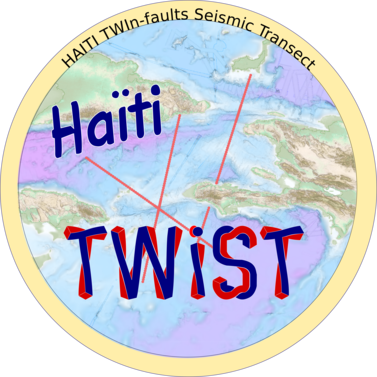2024 Cruises
Direct access to the 2024 marine cruises, by clicking below:
Marine expedition ARMEMS
Chief scientist(s): Mikael Evain (Geo-Ocean / GIPS) ; Pascal Pelleau (Geo-Ocean / ALMA)
Partners: GIPS lab with the financial support of the Joint Research Unit Geo-Ocean and the EUR Isblue project.
Geographical zone: Gulf of Lion, Mediterranean Sea
Dates and ships:
- Leg1 : 25-30 September 2024 - 15 ocean-bottom seismometers deployed from the R/V L’Europe.
- Leg2 : 4-7 November 2024 – The instruments were recovered by the sailing ship Jaja-4.
Equipment: The ocean-bottom seismometers are equipped with velocimeters or accelerometers to record subsurface vibrations in three spatial dimensions, and a hydrophone to record pressure variations on the seabed. They belong partly to Geo-Ocean’s instrument facilities and partly to the company Sercel.
Objectives:
The ARMENS campaign collected 38 days of continuous seismometer recordings.
The main aim of the ECOES project is to process the low frequencies (< 1 Hz) of these recordings. They contain the ambient microseismic noise of the deep waters of the Gulf of Lion, enabling us to map the structure and seismic properties of the subsurface several kilometers below the instruments.
Access to the French Oceanographic Cruises Catalogue: Marine expedition ARMEMS
Marine expedition Haïti-TWiST
Chief scientist(s): Walter Roest (Geo-Ocean) ; Boris Marcaillou (Geoazur – UMR 7329 / UR082) ; Chastity Aiken (Geo-Ocean)
Partners: Ifremer, Géoazur, Sorbonne University, Antilles University, Pau University, URGéo - Université Etat Haïti
Geographical zone: Carribean SeaHaïti, Cuba et Jamaïque
Dates: 31/05/2024 – 22/07/2024
Ship: R/V Pourquoi pas ?
Equipement: HR seismic system ; SMT seismic system ; Sub-bottom profiler ; Multibeam echosounder ; Multi Sensor Core Logger ; Calypso corrers ; Heat flow probe ; micrOBS, broadband ocean bottom seismometers ; Gravimeter ; Magnetometer
Objectives:
The twin transform fault system bounding Haiti -the Septentrional-Oriente Fault Zone and Enriquillo-Plantain Garden Fault Zone is known from paleoseismic and recent records to have produced damaging earthquakes and tsunamis. However, we know very little about these faults' ages and origins, their structures, their modes of fault failure, or even the role of fluids in their faulting processes, all of which are fundamental for understanding their ability to produce earthquakes and tsunamis. Here, we present a multi-disciplinary project spanning the twin transform fault system.
We aim to:
- unravel their tectonic history and constrain their crustal and mantle structure,
- characterize their fault slip behavior,
- identify their thermal states and role of fluids in their faulting processes.
To do so, we propose a deep seismic survey during a first leg, and passive seismic recordings, acoustic water column mapping, high-resolution seafloor cartography, high resolution reflection seismic data acquisition, sediment coring, water sampling, and heat flow measurements in a second leg.
Collectively, these data will image the two transform faults on different spatial resolution scales, as well as reveal how stressed is released along these faults, what role pore or deep fluids may play, and what their thermal states and fluid sources are
Access to the French Oceanographic Cruises Catalogue: Marine Expedition Haïti-TWIST
Marine expedition SEZAM
Chief scientist(s): Gwénael Jouet (Ifremer - Geo-Ocean) and Marina Rabineau (CNRS - Geo-Ocean)
Partners: Ifremer, Université de Toulouse, Nelson Mandela University (South Africa), Université de Montpellier, Université de Brest (Université Flottante)
Mission de la Flotte Océanographique Française (FOF), et cofinancement Ifremer-CNRS-UBO ; avec une Université Flottante à bord avec deux Universités Françaises : Brest (Université de Bretagne Occidentale) et Montpellier (Université de Montpellier) (financement EUR ISBlue-UM), encadrée par Maud Fabre (ISblue, Brest).
Geographical zone: Centre du Canal du Mozambique
Dates: 28/05/2024 – 20/06/2024
Ship: R/V Marion Dufresne
Equipment: Multibram echosounder ; SISRAP ; Sub-bottom profiler ; Calypso corers ; ADCP, Heat flow probe ; Gravimeter ; Magnetometer
Objectives:
The SEZAM campaign will focus on the central part of the Mozambique Canal, around the Eparses Islands, in order to acquire the data needed to understand the supply from the Zambeze River and carbonated sediments produced by the isolated platforms of Europa and Bassas da India mainly.
It will have three main objectives:
- determine the timing of sediment deposition from the Zambeze River towards the basin in connection with paleoclimatic and paleo-environmental variations,
- clarify the role of currents in the distribution of sediments,
- determine the roles of vertical movements (variations in sea level and tectonic) in the sedimentary distribution and accumulation in the Basin.
The cruise will implement 8-10 nds geophysical tools (multi-beam bathymetry, multitrace seismic, subbottom profiler, ADCP) to define the sedimentary and structural architectures of the intermediate basin, around the Eparses Islands. Calypso cores (10 to 50 m) are also planned to sample the different depositional environments, to specify the age and nature of the sediments.
The chronostratigraphic framework will help to understand the source-to-sink system in relation to variations in sea level and climate change over the last 100 thousand years.
You can follow us, day after day, on the students’s blog
Weekly short summary of acquisition can be found HERE.
Youtube videos on the website Science de comptoir (links below):
Access to the French Oceanographic Cruises Catalogue: SEZAM











